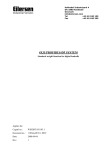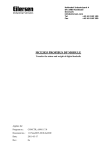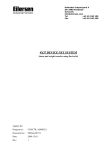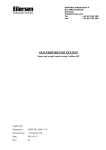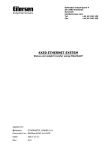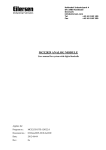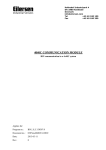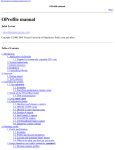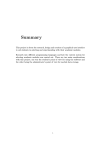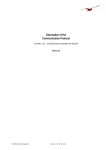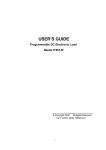Download 1103MU1 WEIGHT MCE2035 Standard Manual UK PDF
Transcript
Kokkedal Industripark 4 DK-2980 Kokkedal DENMARK Tel: +45 49 18 01 00 Fax: +45 49 18 02 00 E-mail: [email protected] MCE2035/MCE2535 PROFIBUS-DP MODULE Standard weight function for digital loadcells Applies for: Cygnal no.: MCE2535.WEIGHT.051103.1 Document no.: 1103MU1.DOC Date: 2005-11-10 Rev.: 1 MCE2035/MCE2535: User manual 1) CONTENTS 1) CONTENTS.....................................................................................................................................2 2) INTRODUCTION ...........................................................................................................................3 2.1 Introduction.................................................................................................................................3 2.2 Profibus-DP specification ...........................................................................................................3 3) DATA EXCHANGE .......................................................................................................................4 3.1 PROFIBUS-DP communication using PPO ...............................................................................4 3.2 PCV Description .........................................................................................................................5 3.3 PCD Description .........................................................................................................................7 3.4 Data formats..............................................................................................................................10 3.4.1 Unsigned integer format (16 bit)....................................................................................10 3.4.2 Signed integer format (32 bit) ........................................................................................10 3.4.3 IEEE754 floating point format (32 bit) ..........................................................................11 4) PARAMETER LIST......................................................................................................................12 4.1 Parameter list ............................................................................................................................12 5) PARAMETER DESCRIPTION ....................................................................................................15 5.1 Parameter description................................................................................................................15 6) STATUS CODES ..........................................................................................................................18 7) ZEROING AND CALIBRATION ................................................................................................19 7.1 Zeroing procedure.....................................................................................................................19 7.2 Calibration procedure................................................................................................................19 8) INSTALATION OF SYSTEM ......................................................................................................21 8.1 Checklist during installation .....................................................................................................21 9) HARDWARE DESCRIPTION .....................................................................................................22 9.1 MCE2035/MCE2535 modul type designations ........................................................................22 9.2 Connection of power and loadcells...........................................................................................22 9.2.1 MCE2035 Standard Connection.....................................................................................22 9.2.2 MCE2535 Standard Connection.....................................................................................23 9.3 DIP-switch settings ...................................................................................................................24 9.4 Light Emitting Diodes...............................................................................................................25 9.5 Jumpers .....................................................................................................................................25 9.6 JTAG connector ........................................................................................................................26 9.7 RS232 connector.......................................................................................................................26 9.8 Profibus-DP connector..............................................................................................................26 9.9 Hardware Selftest......................................................................................................................26 9.10 Update times ...........................................................................................................................26 Version:2005-11-10 rev.: 1 Page: 2 MCE2035/MCE2535: User manual 2) INTRODUCTION 2.1 Introduction This document describes the use of a MCE2535 Profibus-DP module as well as a MCE2035 Profibus-DP module from Eilersen Electric, when they are equipped with the program listed on the front page. The two module types are the same, except that MCE2035 modules as opposed to MCE2535 modules are encased in their own module box. Connectors and the way in which the two module types are connected to power supply and loadcells, are therefore the only differences between the two module types. These differences will appear in the chapters Connection of power and loadcells, while all other chapters will cover both MCE2535 as well as MCE2035 module types. In the following the designation MCE2535 will due to the same reason cover both the MCE2535 and the MCE2035 module, unless it is specified otherwise. With the program specified on the front page, the MCE2535 Profibus-DP module can act as weight for up to 16 loadcells. Each loadcell is connected to the Profibus-DP module through a loadcell interface module. It is possible to connect the MCE2535 Profibus-DP module to a Profibus-DP network, where it will act as a slave. It will then be possible from the Profibus-DP master to read status, read system weight and perform commands such as zeroing and calibration. Exchange of data between master and slave takes place as described in the following. 2.2 Profibus-DP specification The MCE2535 Profibus-DP module confirms to the following Profibus-DP specifications: Protocol: Communications form: Module type: Baud rates [kbit/sec]: Profibus address: Profibus connection: Version:2005-11-10 rev.: 1 Profibus-DP RS485 Slave 9.6, 19.2, 93.75, 187.5, 500, 1500 , 3000, 6000, 12000 0-127 (Sw2.2-Sw2.8) 9-pin sub-D (female) connector Page: 3 MCE2035/MCE2535: User manual 3) DATA EXCHANGE 3.1 PROFIBUS-DP communication using PPO PROFIBUS-DP communication with the MCE2535 communication module uses a so called 'parameter-process data object' (PPO) consisting of 14 bytes. This object is used during reception as well as during transmission of data. The structure of this telegram is as follows: PCV PCD PCA 1 IND 2 3 PVA 4 5 CTW STW 6 7 8 9 MRV MAV 10 11 12 13 14 Byte 14 Byte 1 The telegram is made up of two blocks; a PCV part (the first 8 bytes) and a PCD part (the last 6 bytes). The two blocks are made up as follows: PCV (Parameter-Characteristic-Value) PCA (Bytes 1-2): Parameter Characteristics IND (Bytes 3-4): Not used (reserved for future use) PVA (Bytes 5-8): Parameter value PCD (Process Data) CTW (Bytes 9-10) (Master to Slave): STW (Bytes 9-10) (Slave to Master): MRV (Bytes 11-14) (Master to Slave): MAV (Bytes 11-14) (Slave to Master): Control Word Status Word Main Reference Value Main Actual Value In the following the meaning of the individual blocks in the telegram is described in detail. The byte order (MSB/LSB first) for the individual parts is selected using jumper JU8, and upon factory delivery it is default set to MSB byte first. The data format of the MAV part and parameters in the PVA part is 32 bit signed integer format (2’s complement). It is possible however, by using of jumper JU7 to change so that the MAV part and certain parameters in the PVA part are transferred in IEEE754 floating point format. During transmission/reception of data consisting of several bytes (for example the MAV) it is up to the master (the PLC) to provide for consistent (belonging together) data. Version:2005-11-10 rev.: 1 Page: 4 MCE2035/MCE2535: User manual 3.2 PCV Description The PCV part of the telegram is as mentioned made up of a PCA part, an IND part and a PVA part. As mentioned the IND part is not used, but the functionality of the other two parts of the PCV is described here. PCA handling The PCA part contains a RC part for 'request' and 'response' indication, and a PNU part for indication of parameter number. This is shown in the figure of the PCA block below. Bit 15 15 Bit 0 14 13 12 11 RC RC: TBD: PNU: 10 9 8 7 6 TBD 5 4 3 2 1 0 PNU Request/Response Characteristics Not used Parameter number (Values: 0..15) (Reserved for future use.) (Values: 0..999) RC - Request/Response Characteristics The RC part is used by the master to tell the slave (the weight) what 'requests' are wanted. Similarly the RC part is used by the slave to tell ('response') the master the status/results of the received 'requests'. The RC part further informs which other parts of the PCV (IND and PVA) are used. The contents of the RC part has the following function during request: REQUEST 0 No request 1 Request parameter value 2 Change parameter value (2 bytes) 3 Change parameter value (4 bytes) 4-15 Version:2005-11-10 rev.: 1 FUNCTION Reserved for future use Page: 5 MCE2035/MCE2535: User manual The contents of the RC part has the following function during response: RESPONSE FUNCTION 0 No response 1 Transfer parameter value (2 bytes) 2 Transfer parameter value (4 bytes) 3 Request refused (incl. Error#, see later) 4 Can not be serviced by PCV interface 5-15 Reserved for future use PNU - Parameter number Bit 10 to Bit 0 in the PCA part indicates the parameter number of the parameter to be read/changed. The individual parameters and their function is explained later. PVA handling The PVA part contains 4 bytes for reception and transmission of parameter values. The PVA part will transfer '2 byte' parameters in either bytes 7-8 (MSB first selected) or bytes 5-6 (LSB first selected). ‘4 byte’ parameters are transferred in bytes 5-8. If the slave (the weight) refuses a request from the master the RC part will assume the value 3 (see above) and the actual error code will be transferred in the PVA element. The following error indications are possible: ERROR# Version:2005-11-10 rev.: 1 CAUSE 0 Illegal PNU 1 Reserved for future use 2 Upper or lower limit is exceeded Page: 6 MCE2035/MCE2535: User manual 3.3 PCD Description As mentioned the PCD part of the telegram is made up of a CTW/STW part and a MRV/MAV part. The functionality of the PCD parts is described here. Note that the PCD part (the last 6 bytes) always transfers these data independent of the contents of the PCV part (the first 8 bytes). CTW handling During communication from the master to the slave (the weight) the first two bytes in the PCD part is used as a Control Word (CTW). By use of the Control Word (CTW) it is possible to tell the slave (the weight) how it should react, as different commands can be transferred to the weight. The bit’s in CTW have the following function: BIT-NO FUNCTION 0 Reserved for future use 1 Zero system. 2 Calibrate corner. 3 Calibrate system. 4 Reset calibration. 5-14 15 Reserved for future use Clear error in Error-register. If the Zero system bit is activated all loadcells and thereby the calculated system weight will be zeroed. This should only be done with an empty weighing arrangement. If the Calibrate corner bit is activated the loadcell specified by the Corner-register will be calibrated to the weight indicated by the Calibration load for corner/system register. If the Calibrate system bit is activated the system weight will be calibrated to the weight indicated by the Calibration load for corner/system register. Note that the individual calibration of the loadcells remains unchanged. If the Reset calibration bit is activated all calibration factors (system and all loadcell factors) will be set to their standard value of 32768. If the Clear error in Error-register bit is activated any error in the Error-register will be cleared. Version:2005-11-10 rev.: 1 Page: 7 MCE2035/MCE2535: User manual STW handling During communication from slave (the weight) to the master the first two bytes in the PCD part are used as a Status Word (STW). By reading the Status Word (STW) it is possible for the master to achieve information on the status of the slave (the weight). The functionality of the individual bits in the Status Word (STW) is described below: BIT-NO FUNCTION 0 1-3 LC-error. Reserved for future use 4 Zeroing OK. 5 Zeroing not possible. 6 Calibration OK. 7 Calibration not possible. 8 Reset Calibration OK. 9 Clear Error OK. 10-14 15 Reserved for future use Error detected. If the LC-error bit is ON one or more loadcells detected at power up are in an error state. The actual error can be read in the Status for loadcell X register for the individual loadcell. If the Zeroing OK bit is ON the last zero request has been performed. Note that the bit is cleared during the zero process and after the Zero system bit is cleared again. If the Zero not possible bit is ON the last zero request has not been performed. The reason for this can be read in the Zeroing-register. Note that the bit is cleared during the zero process and after the Zero system bit is cleared again. If the Calibration OK bit is ON the last calibration request has been performed. Note that the bit is cleared during the calibration process and after both the Calibrate corner and Calibrate system bits are cleared again. If the Calibration not possible bit is ON the last calibration request has not been performed. The reason for this can be read in the Calibration-register. Note that the bit is cleared during the calibration process and after both the Calibrate corner and Calibrate system bits are cleared again. If the Reset calibration OK bit is ON the last reset calibration request has been performed. Note that the bit is cleared during the process and after the Reset calibration bit is cleared again. If the Clear error OK bit is ON the last clear error request has been performed. Note that the bit is cleared during the process and after the Clear error in Error-register bit is cleared again. Version:2005-11-10 rev.: 1 Page: 8 MCE2035/MCE2535: User manual If the Error detected bit is ON the system has detected an error. The actual error can be found in the Error-register. MRV handling During communication from the master to the slave (the weight) the four last bytes in the PCD part are used as a Main Reference Value (MRV); a setpoint. The Main Reference Value (MRV) has no function in this program. MAV handling During communication from the slave (the weight) to the master the four last bytes in the PCD part are used as a Main Actual Value (MAV); the actual value. The Main Actual Value (MAV) is used to transfer the actual gross weight of the system. The gross weight must be scaled in accordance to the Exponent for MAV parameter (Par.No.=15) if Gram mode has not been selected using jumper JU1. Default factory setting is that Gram mode is not selected. Note that the MAV part may be transferred in 32 bit signed integer format (default) or in IEEE754 floating point format depending on the actual jumper setting. Version:2005-11-10 rev.: 1 Page: 9 MCE2035/MCE2535: User manual 3.4 Data formats The Profibus-DP communication can transfer data in the following three data formats. If necessary please refer to other literature for further information on these formats. 3.4.1 Unsigned integer format (16 bit) The following are examples of decimal numbers represented on 16 bit unsigned integer format: Decimal 0 1 2 200 2000 20000 Hexadecimal 0x0000 0x0001 0x0002 0x00C8 0x07D0 0x4E20 Binary (MSB first) 00000000 00000000 00000000 00000000 00000111 01001110 00000000 00000001 00000010 11001000 11010000 00100000 3.4.2 Signed integer format (32 bit) The following are examples of decimal numbers represented on 32 bit signed integer format: Decimal Hexadecimal -20000000 -2000000 -200000 -20000 -2000 -200 -2 -1 0 1 2 200 2000 20000 200000 2000000 20000000 0xFECED300 0xFFE17B80 0xFFFCF2C0 0xFFFFB1E0 0xFFFFF830 0xFFFFFF38 0xFFFFFFFE 0xFFFFFFFF 0x00000000 0x00000001 0x00000002 0x000000C8 0x000007D0 0x00004E20 0x00030D40 0x001E8480 0x01312D00 Version:2005-11-10 rev.: 1 Binary (MSB first) 11111110 11111111 11111111 11111111 11111111 11111111 11111111 11111111 00000000 00000000 00000000 00000000 00000000 00000000 00000000 00000000 00000001 11001110 11100001 11111100 11111111 11111111 11111111 11111111 11111111 00000000 00000000 00000000 00000000 00000000 00000000 00000011 00011110 00110001 11010011 01111011 11110010 10110001 11111000 11111111 11111111 11111111 00000000 00000000 00000000 00000000 00000111 01001110 00001101 10000100 00101101 00000000 10000000 11000000 11100000 00110000 00111000 11111110 11111111 00000000 00000001 00000010 11001000 11010000 00100000 01000000 10000000 00000000 Page: 10 MCE2035/MCE2535: User manual 3.4.3 IEEE754 floating point format (32 bit) Representation of data on IEEE754 floating point format is done as follows: Byte1 Byte2 Byte3 Byte4 bit7 bit6 bit0 bit7 bit6 bit0 bit7 bit0 bit7 bit0 7 1 0 -1 -7 -8 -15 -16 S 2 …..…. 2 2 2 ……... 2 2 ………….... 2 2 ………..…. 2-23 Sign Exponent Mantissa Mantissa Mantissa Formula: Value = (-1)S * 2(exponent-127) * (I+Mantissa) Example: Byte1 0100 0000 Byte2 1111 0000 Byte3 0000 0000 Byte4 0000 0000 Value = (-1)0 * 2(129-127) * (1 + 2-1 + 2-2 + 2-3) = 7.5 Please note that if transfer of MSB first has been selected (default setting), the byte with the “sign” will come first in the weight indications, and if LSB first has been selected the byte with the “sign” will come last in the weight indications. Version:2005-11-10 rev.: 1 Page: 11 MCE2035/MCE2535: User manual 4) PARAMETER LIST 4.1 Parameter list A part from main values (MRV/MAV) and control/status word (CTW/STW), which are transferred at all times using the PCD part, it is possible to access the individual parameters one at a time using the PCV part. The following parameters can be read/updated using the PCV part: NO TYPE PARAMETER 0 2R 1 2 RW 2-6 2 7 2R Error-register Bit register for indication of detected errors. 8 2R Zeroing-register Bit register for indication of errors during zeroing. 9 2R Calibration-register Bit register for indication of errors during calibration. 10-14 2 15 2R Exponent for MAV 16 17 18 19 20 21 22 23 24 25 26 27 28 29 30 31 2R 2R 2R 2R 2R 2R 2R 2R 2R 2R 2R 2R 2R 2R 2R 2R Exponent for loadcell 0 Exponent for loadcell 1 Exponent for loadcell 2 Exponent for loadcell 3 Exponent for loadcell 4 Exponent for loadcell 5 Exponent for loadcell 6 Exponent for loadcell 7 Exponent for loadcell 8 Exponent for loadcell 9 Exponent for loadcell 10 Exponent for loadcell 11 Exponent for loadcell 12 Exponent for loadcell 13 Exponent for loadcell 14 Exponent for loadcell 15 LC-register Bit register for indication of connected loadcells detected during power-up. Corner-register Indicates corner (loadcell number) to be corner calibrated. Reserved for future use Reserved for future use Version:2005-11-10 rev.: 1 Page: 12 MCE2035/MCE2535: User manual 32 33 34 35 36 37 38 39 40 41 42 43 44 45 46 47 48 49 50 51 52 53 54 55 56 57 58 59 60 61 62 63 64 65 66 67 68 69 70 71 72 73 74 75 76 77 78 79 80* 81* 2R 2R 2R 2R 2R 2R 2R 2R 2R 2R 2R 2R 2R 2R 2R 2R 4R 4R 4R 4R 4R 4R 4R 4R 4R 4R 4R 4R 4R 4R 4R 4R 4R 4R 4R 4R 4R 4R 4R 4R 4R 4R 4R 4R 4R 4R 4R 4R 4 RW 4 RW Status for loadcell 0 Status for loadcell 1 Status for loadcell 2 Status for loadcell 3 Status for loadcell 4 Status for loadcell 5 Status for loadcell 6 Status for loadcell 7 Status for loadcell 8 Status for loadcell 9 Status for loadcell 10 Status for loadcell 11 Status for loadcell 12 Status for loadcell 13 Status for loadcell 14 Status for loadcell 15 Actual gross weight for loadcell 0 Actual gross weight for loadcell 1 Actual gross weight for loadcell 2 Actual gross weight for loadcell 3 Actual gross weight for loadcell 4 Actual gross weight for loadcell 5 Actual gross weight for loadcell 6 Actual gross weight for loadcell 7 Actual gross weight for loadcell 8 Actual gross weight for loadcell 9 Actual gross weight for loadcell 10 Actual gross weight for loadcell 11 Actual gross weight for loadcell 12 Actual gross weight for loadcell 13 Actual gross weight for loadcell 14 Actual gross weight for loadcell 15 Actual signal for loadcell 0 Actual signal for loadcell 1 Actual signal for loadcell 2 Actual signal for loadcell 3 Actual signal for loadcell 4 Actual signal for loadcell 5 Actual signal for loadcell 6 Actual signal for loadcell 7 Actual signal for loadcell 8 Actual signal for loadcell 9 Actual signal for loadcell 10 Actual signal for loadcell 11 Actual signal for loadcell 12 Actual signal for loadcell 13 Actual signal for loadcell 14 Actual signal for loadcell 15 Actual zero for loadcell 0 Actual zero for loadcell 1 Version:2005-11-10 rev.: 1 Page: 13 MCE2035/MCE2535: User manual 82* 83* 84* 85* 86* 87* 88* 89* 90* 91* 92* 93* 94* 95* 96* 97* 98* 99* 100* 101* 102* 103* 104* 105* 106* 107* 108* 109* 110* 111* 112* 4 RW 4 RW 4 RW 4 RW 4 RW 4 RW 4 RW 4 RW 4 RW 4 RW 4 RW 4 RW 4 RW 4 RW 4 RW 4 RW 4 RW 4 RW 4 RW 4 RW 4 RW 4 RW 4 RW 4 RW 4 RW 4 RW 4 RW 4 RW 4 RW 4 RW 4 RW Actual zero for loadcell 2 Actual zero for loadcell 3 Actual zero for loadcell 4 Actual zero for loadcell 5 Actual zero for loadcell 6 Actual zero for loadcell 7 Actual zero for loadcell 8 Actual zero for loadcell 9 Actual zero for loadcell 10 Actual zero for loadcell 11 Actual zero for loadcell 12 Actual zero for loadcell 13 Actual zero for loadcell 14 Actual zero for loadcell 15 Corner calibration factor for loadcell 0 Corner calibration factor for loadcell 1 Corner calibration factor for loadcell 2 Corner calibration factor for loadcell 3 Corner calibration factor for loadcell 4 Corner calibration factor for loadcell 5 Corner calibration factor for loadcell 6 Corner calibration factor for loadcell 7 Corner calibration factor for loadcell 8 Corner calibration factor for loadcell 9 Corner calibration factor for loadcell 10 Corner calibration factor for loadcell 11 Corner calibration factor for loadcell 12 Corner calibration factor for loadcell 13 Corner calibration factor for loadcell 14 Corner calibration factor for loadcell 15 Calibration factor for system 113 4 RW Calibration load for corner/system 114-127 4 Reserved for future use Note that NO indicates the parameter number for the parameter in question. Note that TYPE indicates the length of the parameter in question (2 = 2 bytes and 4 = 4 bytes). In addition after the length it is indicated whether its a read and write register (RW = ReadWrite) or its a read only register (R = Read). Note that data values are transferred as 2 complement signed values. Note that a * after the parameter number indicates that the parameter in question is stored in the SEEPROM of the module, why this parameter can be remembered after power has been disconnected. Please note that no zeroing or calibration is performed at power-up. Version:2005-11-10 rev.: 1 Page: 14 MCE2035/MCE2535: User manual 5) PARAMETER DESCRIPTION 5.1 Parameter description The individual parameters have the following functions: LC-register is a bit register for indication of connected loadcells detected at power-up. Hence bit 0-15 will be ON, if the corresponding loadcell was detected during power-up.. Corner-register indicates which corner (loadcell number) that has to be corner calibrated. The loadcell number corresponds to the loadcell module address. Hence values in the interval 0-15 are valid. Values in the interval 16-65535 indicates that the calibration corner is not selected. Error-register is a bit register for indication of detected errors. The individual bits have the following function: BIT-NO FUNCTION 0 A checksum error for storage of zero and calibration in the SEEPROM of the module was detected during power-up. 1 A calibration factor was out of range during power-up (or scale is not calibrated). 2 A zero was invalid during power-up (or scale has not been zeroed). 3 Inconsistency between number of detected loadcells during power on and the number of loadcells indicated using Sw1.1-Sw1.4. 4-15 Reserved for future use Zero-register is a bit register for indication of errors during zero. The individual bits have the following function: BIT-NO 0 1-15 Version:2005-11-10 rev.: 1 FUNCTION LC-error during zero Check status for the individual loadcells. Reserved for future use Page: 15 MCE2035/MCE2535: User manual Calibration-register is a bit register for indication of errors during calibration. The individual bits have the following function: BIT-NO FUNCTION 0 LC-error during calibration Check status for the individual loadcells. 1 Calibration load not selected/valid Check that a valid calibration load has been selected. 2 Calibration corner not selected/valid Check that a valid calibration corner has been selected. 3 Calibration range exceeded It was not possible to calibrate the system within the valid calibration range. Check that nothing is affecting the weighing arrangement mechanically. Check that the value in the Calibration load for corner/system register corresponds to the actual load. 4 Gross weight was negative during calibration Check the gross weight and whether it shows zero without any load. 5-15 Reserved for future use Exponent for MAV is a register containing the exponent for the MAV. If Gram mode has not been selected using jumper JU1, the transferred gross weight has to be compared with this exponent. It indicates the "resolution” of the MAV (gross weight) as described under Exponent for loadcell X. The exponent corresponds to the smallest loadcell exponent. Exponent for loadcell X is a register containing the exponent of loadcell X. The transferred weighing result has to be compared with the exponent for the loadcells. The exponent is a fixed value (2 complement) for a given loadcell, and it indicates the "resolution" of the loadcell (weighing result) as follows: Exponent [Decimal] Exponent [Hexadecimal] Conversion factor to gram SI unit -3 -2 -1 0 1 2 3 4 5 6 0xFFFD 0xFFFE 0xFFFF 0x0000 0x0001 0x0002 0x0003 0x0004 0x0005 0x0006 *10-3 *10-2 *10-1 *100 *101 *102 *103 *104 *105 *106 mg Version:2005-11-10 rev.: 1 gram Kg ton Page: 16 MCE2035/MCE2535: User manual Status for loadcell X is a register containing the actual status for loadcell X. The meaning of the status code can be found in the STATUS CODES chapter. Actual gross weight for loadcell X contains the actual gross weight for loadcell X. The gross weight is the actual load signal for the loadcell adjusted by zero and calibration factor. Note that the value is a value averaged over 200 ms. Actual signal for loadcell X contains the actual signal for loadcell X. The actual signal is the actual load signal for the loadcell without any adjustment fir zero and calibration factor. Note that the value is a value averaged over 200 ms. Actual zero for loadcell X contains the actual zero value for loadcell X. The value is determined during zero from Actual signal for loadcell X. Corner calibration factor for loadcell X contains the calibration factor for loadcell X. The value is determined during calibration of corner X, and lies in the interval 24576-40960 with 32768 as center value (standard calibration factor corresponding to no calibration). Calibration factor for system contains the system calibration factor. The value is determined during calibration of the system, and lies in the interval 24576-40960 with 32768 as center value (standard calibration factor corresponding to no calibration). Calibration load for corner/system must contain the load used during calibration of the system or corner. Note that this parameter is always transferred in the same format as the MAV. The format may vary depending on the actual jumper settings (MSB/LSB first, SI32/IEEE754 format and Standard/Gram mode). Version:2005-11-10 rev.: 1 Page: 17 MCE2035/MCE2535: User manual 6) STATUS CODES Status codes are shown as a 4 digit hex number. If more than one error condition is present the error codes are OR’ed together. CODE (Hex) 0001 0002 0004 0008 0010 0020 0040 0080 0100 0200 0400 0800 1000 2000 4000 8000 CAUSE Invalid/missing ’sample’ ID Bad connection between communication module and loadcell module. Not all telegrams from communication module are received in loadcell module. Loadcell timeout Check that the loadcell is connected to the loadcell module. Loadcell not synchronized Bad connection between loadcell and loadcell module, or very powerful under- or overload. Hardware synchronization error Loadcell samples are not synchronized. Cable between loadcell modules shorted or disconnected. Power failure Supply voltage to loadcells is to low. Overflow in weight calculation Internal error in loadcell module. Invalid/missing ’latch’ ID Bad connection between communication module and loadcell module. Not all telegrams from communication module is received in loadcell module. No answer from loadcell module No data is received from this loadcell module. This can be caused by the removal of the loadcell module, no power to the module or that the connection between loadcell module and communication module is broken. Reserved for future use Reserved for future use Reserved for future use No loadcell modules answer Bad connection between communication module and loadcell module. Not all telegrams from communication module are received in loadcell module. Reserved for future use Reserved for future use Reserved for future use Wrong number of loadcells The number of detected loadcells at power-up does not match the number indicated on Sw1.1-Sw1.4. Version:2005-11-10 rev.: 1 Page: 18 MCE2035/MCE2535: User manual 7) ZEROING AND CALIBRATION 7.1 Zeroing procedure Zeroing of the system (all loadcells) should be done using the following procedure: 1) The weighing arrangement should be empty and clean. 2) The Zero system bit in the Control Word is activated. Note that zeroing is only done on the 0-1 transition. 3) By reading the Zeroing OK and the Zeroing not possible bits it is possible to read the result of the desired zeroing. If zeroing is not possible the reason can be read in the Zeroing-register. It is always possible to read the achieved or used zero by reading from the parameter numbers where the loadcell zeroes are stored. If in possession of a zero from a previous zeroing it is possible to insert this zero by writing to the parameter numbers where the loadcell zeroes are stored. Note that no zeroing is performed at power-on. 7.2 Calibration procedure Fine calibration of the system should be performed using the following procedure: 1) Check that the weighing arrangement is empty, and that the gross weight is zero. Zero if necessary. 2) Place a known load on the weighing arrangement. 3) Transfer the value for the known load to the Calibration load for corner/system register. 4) The Calibrate system bit in the Control Word is activated. Note that calibration is only done on the 0-1 transition. 5) By reading the Calibration OK and the Calibration not possible bits it is possible to read the result of the desired calibration. If calibration is not possible the reason can be read in the Calibration-register. 6) If Calibration OK is indicated the transferred gross weight should now match the used calibration load and the calibration factor has been updated. If Calibration not possible is indicated the system calibration factor is not changed. If a corner calibration of the weighing arrangement is desired, the above listed procedure can still be used as the following is taken into account: Version:2005-11-10 rev.: 1 Page: 19 MCE2035/MCE2535: User manual 1) Corner calibration should be performed prior to system calibration. During corner calibration the Calibration factor for system should be set to its standard value of 32768. 2) Corner calibration is done one corner at a time, where the above listed procedure is used for each corner. 3) The actual calibration corner is selected in the Corner-register prior to start of corner calibration. The corner number corresponds to the loadcell communication address which is set on the matching loadcell module. If in doubt the loadcell number can be verified by finding the Actual gross weight for loadcell X, which gives a corresponding signal change when a load is placed/removed directly above the actual loadcell. 4) It is the Calibrate corner bit in the Control Word (CTW), that has to be activated and not the Calibrate system bit. 5) The used calibration load must be placed directly above the actual loadcell, so that it is this loadcell that absorbs the "entire" load. 6) It is not the system gross weight, that has to be observed but the Actual gross weight for loadcell X. If the other loadcells are completely unloaded, this value should correspond with the system gross weight. 7) Every corner calibration only changes the calibration factor for the corresponding corner. The other corner and system calibration factors remain unchanged. It is always possible to read the achieved or used calibration factors by reading from the parameter numbers where the calibration factors are stored. If in possession of calibration factors from a previous calibration, it is possible to insert these by writing to the parameter numbers where the calibration factors are stored. Note that no calibration is performed at power-on. Version:2005-11-10 rev.: 1 Page: 20 MCE2035/MCE2535: User manual 8) INSTALATION OF SYSTEM 8.1 Checklist during installation During installation of the system the following should be checked: 1) 2) 3) 4) 5) 6) 7) 8) 9) 10) 11) 12) 13) 14) 15) The Profibus-DP master should be configured to communicate with the ProfibusDP module (MCE2035/MCE2535) using the supplied GSD file. When configuring with the GSD file always select a MCE2535 station type. This also applies for a MCE2035 module. All hardware connections mentioned below are made as described depending on whether it is a MCE2035 module or a MCE2535 module. The loadcells are mounted mechanically and connected to the Profibus-DP module using their corresponding loadcell interface module. The loadcell addresses are set using the DIP-switches on the loadcell interface modules, so that they forth running from address 0 (0-15). The number of connected loadcells is set on the Profibus-DP module using Sw1.1-Sw1.4 as described below. The Profibus-DP module is connected to the Profibus-DP network, and possibly a termination is made at this Profibus-DP slave. The address of the Profibus-DP module is set using Sw2.2-Sw2.8. Power is applied and the Profibus-DP communication is started. Verify that the red LED (PBE) on the Profibus-DP module is NOT lit, and that the yellow LEDs (DES and RTS) are lit/flashing. Verify that the TXBB LED on the Profibus-DP module is lit and that the TXBB LED’s on the loadcell interface modules are also lit (can flash slightly). Verify that the Profibus-DP module has found the correct loadcells (Par.No.=0), and that no loadcell errors are indicated in the Status Word (STW). Check that the loadcell exponents (Par.No.=16-31) are identical. Reset all calibration factors by using the Reset Calibration bit in the Control Word (CTW). Zero the system weight with empty weighing arrangement by using the “Zeroing procedure” described earlier. Verify that every loadcell gives a signal (Par.No.=48-63) by placing a load directly above each loadcell one after the other (possibly with a known load). Place a known load on the weighing arrangement, and check that the system weight (MAV) corresponds to the load. Does the master take the exponent (scaling) into account if Gram mode has not been selected? Zero the system weight with empty weighing arrangement by using the “Zeroing procedure” described earlier. Place a known load (as close to maximum load as possible) on the weighing arrangement. If the system weight deviates to much from the actual load a fine calibration of the system is made using the “Calibration procedure” described earlier. The system is now installed and a final check is made before the system is taken into usage. Possibly make a note of all zeroes (Par.No.=80-95) and calibration factors (Par.No,=96-112) for later use. Note that in the above checklist no consideration has been made on which functions are implemented on the Profibus-DP master. Version:2005-11-10 rev.: 1 Page: 21 MCE2035/MCE2535: User manual 9) HARDWARE DESCRIPTION 9.1 MCE2035/MCE2535 modul type designations The Profibus-DP module is designated as either a MCE2035 module or a MCE2535 module. The two module types are the same, except that MCE2035 modules as opposed to MCE2535 modules are encased in their own module box. Connectors and the way in which the two module types are connected to power supply and loadcells, are therefore the only differences between the two module types. These differences will appear in the chapters Connection of power and loadcells. 9.2 Connection of power and loadcells This chapter describes the connection of power supply and loadcells for a MCE2035 module and a MCE2535 module respectively. 9.2.1 MCE2035 Standard Connection The 10 pole connector (J2) on the MCE2035 module is connected to the 10 pole connectors on the loadcell interface modules (MCE9610/MCE2010) and to the 10 pole connector on the MCE9601 connection module using the supplied ribbon cable with mounted connectors. Through this bus cable connection of power supply to the individual modules is achieved and data can be transferred from the loadcell modules to the MCE2035 module. The MCE9601 module has the following connections in the blue connector (J1): MCE9601 CONNECTOR CONNECTION GND B (DATA- ) A (DATA+) GND +24V GND I/O +24VDC (Vin) 0 VDC (GNDin) - The 10 pole connector (J2) on the MCE2035 Profibus-DP module has these connections: Version:2005-11-10 rev.: 1 MCE2035 J2 CONNECTER FUNCTION J2.1 - J2.2 J2.3 - J2.4 J2.5 - J2.6 J2.7 - J2.8 J2.9 - J2.10 RS485-B (DATA- ) RS485-A (DATA+) 0 VDC (GNDin) +24VDC (Vin) I/O line Page: 22 MCE2035/MCE2535: User manual 9.2.2 MCE2535 Standard Connection The 2 pole connector (J6) on the MCE2535 module is connected to 24VDC. The 14 pole connector (J7) on the MCE2535 module is connected to the 14 pole connectors on the loadcell interface modules (MCE2510) using the supplied ribbon cable with mounted connectors. Through this bus cable the MCE2535 module supplies the loadcell modules with +3.3VDC and +24VDC, and data can be transferred from the loadcell modules to the MCE2535 module. The 2 pole connector (J6) on the MCE2535 Profibus-DP module has these connections: MCE2535 J6 CONNECTOR CONNECTION J6.1 J6.2 +24VDC (Vin) 0 VDC (GNDin) The 14 pole connector (J7) on the MCE2535 Profibus-DP module has these connections: MCE2535 J7 CONNECTER FUNCTION J2.1 - J2.2 J2.3 - J2.4 J2.5 - J2.6 J2.7 - J2.8 J2.9 - J2.10 J2.11 - J2.12 J2.13 - J2.14 RS485-B (DATA- ) RS485-A (DATA+) 0 VDC (GNDin) +24VDC (Vin) I/O line 0 VDC (GNDin) +3.3VDC Version:2005-11-10 rev.: 1 Page: 23 MCE2035/MCE2535: User manual 9.3 DIP-switch settings This chapter applies to Profibus-DP modules of both the MCE2035 and MCE2535 type. The Profibus-DP module is equipped with a 4 pole DIP-switch block that has the following function: SWITCH Sw1.1-Sw1.4 FUNCTION Expected number of loadcells The expected number of loadcells is set as indicated below. Note that these switches are only read at power-up. where the number of loadcells is indicated using Sw1.1-Sw1.4 as follows: Sw1.1 Sw1.2 Sw1.3 Sw1.4 Number of loadcells OFF OFF OFF OFF OFF OFF OFF OFF ON ON ON ON ON ON ON ON OFF OFF OFF OFF ON ON ON ON OFF OFF OFF OFF ON ON ON ON OFF OFF ON ON OFF OFF ON ON OFF OFF ON ON OFF OFF ON ON OFF ON OFF ON OFF ON OFF ON OFF ON OFF ON OFF ON OFF ON 16 1 2 3 4 5 6 7 8 9 10 11 12 13 14 15 In addition a 8 pole DIP-switch block that has the following function: SWITCH Sw2.1 Sw2.2-Sw2.8 Version:2005-11-10 rev.: 1 FUNCTION Reserved for future use Selection of Profibus-DP communication address The address is selected as the DIP-switches are binary coded, so Sw2.2 is MSB and Sw2.8 is LSB. Note that these switches are only read during power on. Page: 24 MCE2035/MCE2535: User manual 9.4 Light Emitting Diodes This chapter applies to Profibus-DP modules of both the MCE2035 and MCE2535 type. The Profibus-DP module is equipped with 6 light emitting diodes (LED). These LED’s have the following function: LED TXBB (Green) D1 (Green) D2 (Green) PBE (Red) DES (Yellow) RTS (Yellow) FUNCTION Communication with loadcells Profibus-DP module is communicating with loadcells. Reserved for future use Reserved for future use Profibus Error (when initializing the SPC3) The SPC3 Profibus-DP controller was not initialized correctly. Data Exchange State Exchange of data between Profibus-DP slave and master. RtS signal (SPC3) The Profibus-DP module sends to the master. 9.5 Jumpers This chapter applies to Profibus-DP modules of both the MCE2035 and MCE2535 type. The Profibus-DP module is equipped with 7 jumpers. These jumpers have these functions: JUMPER JU1 FUNCTION Selection of (Standard mode) / (Gram mode) The jumper determines if certain weight indications in the telegram are in standard format (must be scaled according to the exponent) or directly in grams. OFF: Standard mode (normal setting from factory) ON: Gram mode JU2-JU4 Reserved for future use (termination) (normal default factory setting is OFF) JU6 Reserved for future use (normal default factory setting is OFF) JU7 Selection of (32 Bit Signed Integer) / (IEEE754) data format The jumper determines if certain weight indications in the telegram are in 32 bit signed integer or in IEEE754 floating point format. OFF: 32 bit signed integer format (normal setting from factory) ON: IEEE754 floating point format JU8 Selection of LSB/MSB data format The jumper determines the byte order in which data are transmitted/received. OFF: LSB first ON: MSB first (normal setting from factory) Version:2005-11-10 rev.: 1 Page: 25 MCE2035/MCE2535: User manual 9.6 JTAG connector This chapter applies to Profibus-DP modules of both the MCE2035 and MCE2535 type. The Profibus-DP module is equipped with an internal JTAG connector. The connector (J5) is used exclusively by Eilersen Electric A/S for download of software to the Cygnal processor. 9.7 RS232 connector This chapter applies to Profibus-DP modules of both the MCE2035 and MCE2535 type. The Profibus-DP module is equipped with an RS232 connector. The connector (J4) is used exclusively by Eilersen Electric A/S for connection to a PC for configuration/monitoring of the Profibus-DP module. 9.8 Profibus-DP connector This chapter applies to Profibus-DP modules of both the MCE2035 and MCE2535 type. The Profibus-DP module is equipped with a nine pole female sub-D connector (J1) for connection to the Profibus-DP network. The connector is a standard Profibus-DP connector. Termination of the Profibus should take place in the sub-D connector (male) of the cable. The specific terminals in the connector have the following function: J1 TERMINALS J1.1 J1.2 J1.3 J1.4 J1.5 J1.6 J1.7 J1.8 J1.9 FUNCTION Not used Not used RS485-A (positive line) (Siemens designation: B line) Request to Send (RTS) 0 VDC (Gnd) +5VDC (Vout) Not used RS485-B (negative line) (Siemens designation: A line) Not used Note that some companies use different designations for the RS485-A and the RS485-B lines. Therefore the polarity of the lines has been listed. 9.9 Hardware Selftest This chapter applies to Profibus-DP modules of both the MCE2035 and MCE2535 type. During power-on the Profibus-DP module will perform a hardware selftest. The test will cause the light emitting diodes D1, D2 and PBE to turn on and off shortly, one at a time. 9.10 Update times This chapter applies to Profibus-DP modules of both the MCE2035 and MCE2535 type. All loadcells are sampled over a period of 200 mS. The hereby found loadcell signals are used in the Profibus-DP communication until new signals are achieved when the next sample period expires. Update times across the Profibus-DP communication depends on the specific Profibus-DP configuration (selected baudrate, number of slaves, scan times etc.). Version:2005-11-10 rev.: 1 Page: 26


























